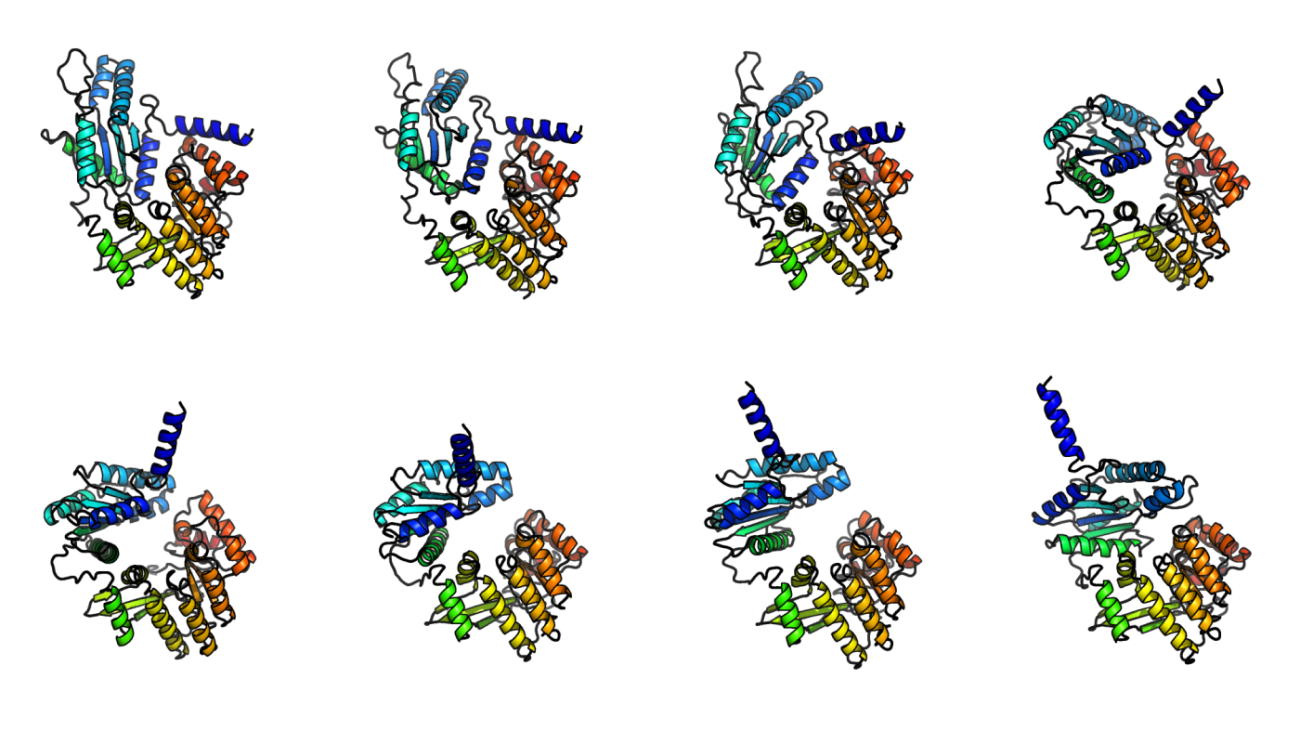CHETAN NAYAK: Thank you. Thanks for having me. And I’m excited to tell you about this stuff.
HUIZINGA: Well, you have a huge list of accomplishments, accolades, and awards—little alliteration there. But I want to start by getting to know a bit more about you and what got you there. So specifically, what’s your “research origin story,” as it were? What big idea inspired you to study the smallest parts of the universe?
NAYAK: It’s a great question. I think if I really have to go back to the origin story, it starts when I was a kid, you know, probably a preteen. And, you know, I’d go to bookstores to … I know, I guess many of the people listening to this may not know what that is, [LAUGHTER] but there used to be these brick-and-mortar storefronts where they would sell books, physical books, …
HUIZINGA: Right.
NAYAK: … and I’d go to bookstores to, you know, to buy books to read, you know, fiction. But I would browse through them, and there’d be a nonfiction section. And often there’d be used books, you know, sometimes used textbooks or used popular science books. And I remember, even though they were bookstores, not libraries, I would spend a lot of time there leafing through books and got exposed to—accidentally exposed to—a lot of ideas that I wouldn’t otherwise have been. You know, just, sort of, you know, I maybe went there, you know, looking to pick up the next Lord of the Rings book, and while I was there, you know, wander into a book that was sort of explaining the theory of relativity to non-scientists. And I remember leafing through those books and actually reading about Einstein’s discoveries, you know, most famously E = mc2, but actually a lot of those books were explaining these thought experiments that Einstein did where he was thinking about, you know, if he were on a train that were traveling at the speed of light, what would light look like to him? [LAUGHTER] Would he catch up to it? You know, and all these incredible thought experiments that he did to try to figure out, you know, to really play around with the basic laws as they were currently understood, of physics, and by, you know, stretching and pulling them and going into extreme … taking them to extreme situations, you could either find the flaws in them or in some cases see what the next steps were. And that was, you know, really inspirational to me. I, you know, around the same time, also started leafing through various advanced math books and a little later picked up a book on calculus and started flipping through it, used book with, like, you know, the cover falling apart and the pages starting to fall out. But there was a lot of, you know, accidental discovery of topics through wandering through bookstores, actually. I also, you know, went to this great magnet high school in New York City called Stuyvesant High School, where I was surrounded by people who were really interested in science and math and technology. So I think, you know, for me, that origin story really starts, you know, maybe even earlier, but at least in my preteen years when, you know, I went through a process of learning new things and trying to understand them in my own way. And the more you do that, eventually you find maybe you’re understanding things in a little different way than anybody else ever did. And then pretty soon, you know, you’re discovering things that no one’s ever discovered before. So that’s, sort of, how it started.
HUIZINGA: Yeah. Well, I want to drill in a little bit there because you’ve brought to mind a couple of images. One is from a Harry Potter movie, And the Half-Blood Prince, where he discovers the potions handbook, but it’s all torn up and they were fighting about who didn’t get that book. And it turned out to be … so there’s you in a bookstore somewhere between the sci-fi and the non-fi, shall we call it. And you’re, kind of, melding the two together. And I love how you say, I was accidentally exposed. [LAUGHTER] Sounds kind of like radiation of some kind and you’ve turned into a scientist. A little bit more on that. This idea of quantum, because you’ve mentioned Albert Einstein, there’s quantum physics, quantum mechanics, now quantum computing. Do these all go together? I mean, what came out of what in that initial, sort of, exploration with you? Where did you start getting interested in the quantum of things?
NAYAK: Yeah, so I definitely started with relativity, not quantum. That was the first thing I heard about. And I would say in a lot of ways, that’s the easier one. I mean, those are the two big revolutions in physics in the 20th century, relativity and quantum theory, and quantum mechanics is by far, at least for me and for many people, the harder one to get your head around because it is so counterintuitive. Quantum mechanics in some sense, or quantum theory in some sense, for most of what we experience in the world is down many abstraction layers away from what we experience. What I find amazing is that the people who created, you know, discovered quantum mechanics, they had nothing but the equations to guide them. You know, they didn’t really understand what they were doing. They knew that there were some holes or gaps in the fundamental theory, and they kind of stumbled into these equations, and they gave the right answers, and they just had to follow it. I was actually just a few weeks ago, I was in Arosa, which is a small Swiss town in the Alps. That’s actually the town where Schrödinger discovered Schrödinger’s equation.
HUIZINGA: No!
NAYAK: Yeah, a hundred years ago, this summer …
HUIZINGA: Amazing!
NAYAK: So Schrödinger suffered tuberculosis, which eventually actually killed him much later in his life. And so he went into the mountains …
HUIZINGA: … for the cure.
NAYAK: … for his health, yeah, to a sanatorium to recover from tuberculosis. And while he was there in Arosa, he discovered his equation. And it’s a remarkable story because, you know, that equation, he didn’t even know what the equation meant. He just knew, well, particles are waves, and waves have wave equations. Because that’s ultimately Maxwell’s equation. You can derive wave equations for light waves and radio waves and microwaves, x-rays. And he said, you know, there has to be a wave equation for this thing and this wave equation needs to somehow correctly predict the energy levels in hydrogen.
HUIZINGA: Oh, my gosh.
NAYAK: And he, you know, worked out this equation and then solved it, which is for that time period not entirely trivial. And he got correctly the energy levels of hydrogen, which people had … the spectra, the different wavelengths of light that hydrogen emits. And lo and behold, it works. He had no idea why. No idea what it even meant. And, um, but knew that he was onto something. And then remarkably, other people were able to build on what he’d done, were able to say, no, there must be a grain of truth here, if not the whole story, and let’s build on this, and let’s make something that is richer and encompasses more and try to understand the connections between this and other things. And Heisenberg was, around the same time, developing his what’s called matrix mechanics, a different way of thinking about quantum computing, and then people realize the connections between those, like Dirac. So it’s a remarkable story how people, how scientists, took these things they understood, you know, imposed on it a certain level of mathematical consistency and a need for the math to predict things that you could observe, and once you had, sort of, the internal mathematical consistency and it was correctly explaining a couple of data points about the world, you could build this huge edifice based on that. And so that was really impressive to me as I learned that. And that’s 100 years ago! It was 1925.
HUIZINGA: Right. Well, let me …
NAYAK: And that’s quantum mechanics!
HUIZINGA: OK.
NAYAK: You’re probably going to say, well, how does quantum computing fit into this, you know? [LAUGHTER] Right? And that’s a much later development. People spent a long time just trying to understand quantum mechanics, extend it, use it to understand more things, to understand, you know, other particles. So it was initially introduced to understand the electron, but you could understand atoms, molecules, and subatomic things and quarks and positrons. So there was a rich, you know, decades of development and understanding, and then eventually it got combined with relativity, at least to some extent. So there was a lot to do there to really understand and build upon the early discoveries of quantum mechanics. One of those directions, which was kicked off by Feynman around, I think, 1982 and independently by a Russian mathematician named Yuri Manin was, OK, great, you know, today’s computers, again, is many abstraction layers away from anything quantum mechanical, and in fact, it’s sort of separated from the quantum world by many classical abstraction layers. But what if we built a technology that didn’t do that? Like, that’s a choice. It was a choice. It was a choice that was partially forced on us just because of the scale of the things we could build. But as computers get smaller and smaller and the way Moore’s law is heading, you know, at some point, you’re going to get very close to that point at which you cannot abstract away quantum mechanics, [LAUGHTER] where you must deal with quantum mechanics, and it’s part and parcel of everything. You are not in the fortunate case where, out of quantum theory has emerged the classical world that behaves the way we expect it to intuitively. And, you know, once we go past that, that potentially is really catastrophic and scary because, you know, you’re trying to make things smaller for the sake of, you know, Moore’s law and for making computers faster and potentially more energy efficient. But, you know, if you get down to this place where the momentum and position of things, of the electrons, you know, or of the currents that you’re relying on for computation, if they’re not simultaneously well-defined, how are you going to compute with that? It looks like this is all going to break down. And so it looks like a real crisis. But, you know, what they realized and what Feynman realized was actually it’s an opportunity. It’s actually not just a crisis. Because if you do it the right way, then actually it gives you way more computational power than you would otherwise have. And so rather than looking at it as a crisis, it’s an opportunity. And it’s an opportunity to do something that would be otherwise unimaginable.
HUIZINGA: Chetan, you mentioned a bunch of names there. I have to say I feel sorry for Dr. Schrödinger because most of what he’s known for to people outside your field is a cat, a mysterious cat in a box, meme after meme. But you’ve mentioned a number of really important scientists in the field of quantum everything. I wonder, who are your particular quantum heroes? Are there any particular, sort of, modern-day 21st-century or 20th-century people that have influenced you in such a way that it’s like, I really want to go deep here?
NAYAK: Well, definitely, you know, the one person I mentioned, Feynman, is later, so he’s the second wave, you could say, of, OK, so if the first wave is like Schrödinger and Heisenberg, and you could say Einstein was the leading edge of that first wave, and Planck. But … and the second wave, maybe you’d say is, is, I don’t know, if Dirac is first or second wave. You might say Dirac is second wave and potentially Landau, a great Russian physicist, second wave. Then maybe Feynman’s the third wave, I guess? I’m not sure if he’s second or third wave, but anyway, he’s post-war and was really instrumental in the founding of quantum computing as a field. He had a famous statement, which is, you know, in his lectures, “There’s always room at the bottom.” And, you know, what he was thinking about there was, you can go to these extreme conditions, like very low temperatures and in some cases very high magnetic fields, and new phenomena emerge when you go there, phenomena that you wouldn’t otherwise observe. And in a lot of ways, many of the early quantum theorists, to some extent, were extreme reductionists because, you know, they were really trying to understand smaller and smaller things and things that in some ways are more and more basic. At the same time, you know, some of them, if not all of them, at the same time held in their mind the idea that, you know, actually, more complex behaviors emerge out of simple constituents. Einstein famously, in his miracle year of 1905, one of the things he did was he discovered … he proposed the theory of Brownian motion, which is an emergent behavior that relies on underlying atomic theory, but it is several layers of abstraction away from the underlying atoms and molecules and it’s a macroscopic thing. So Schrödinger famously, among the other things, he’s the person who came up with the concept of entanglement …
HUIZINGA: Yes.
NAYAK: … in understanding his theory. And for that matter, Schrödinger’s cat is a way to understand the paradoxes that occur when the classical world emerges from quantum mechanics. So they were thinking a lot about how these really incredible, complicated things arise or emerge from very simple constituents. And I think Feynman is one those people who really bridged that as a post-war scientist because he was thinking a lot about quantum electrodynamics and the basic underlying theory of electrons and photons and how they interact. But he also thought a lot about liquid helium and ultimately about quantum computing. Motivation for him in quantum computing was, you have these complex systems with many underlying constituents and it’s really hard to solve the equation. The equations are basically unsolvable.
HUIZINGA: Right.
NAYAK: They’re complicated equations. You can’t just, sort of, solve them analytically. Schrödinger was able to do that with his equation because it was one electron, one proton, OK. But when you have, you know, for a typical solid, you’ll have Avogadro’s number of electrons and ions inside something like that, there’s no way you’re going to solve that. And what Feynman recognized, as others did, really, coming back to Schrödinger’s observation on entanglement, is you actually can’t even put it on a computer and solve a problem like that. And in fact, it’s not just that with Avogadro’s number you can’t; you can’t put it on a computer and solve it with a thousand, you know, [LAUGHTER] atoms, right? And actually, you aren’t even going to be able to do it with a hundred, right. And when I say you can’t do that on a computer, it’s not that, well, datacenters are getting bigger, and we’re going to have gigawatt datacenters, and then that’s the point at which we’ll be able to see—no, the fact is the amazing thing about quantum theory is if, you know, you go from, let’s say, you’re trying to solve a problem with 1,000 atoms in it. You know, if you go to 1,001, you’re doubling the size of the problem. As far as if you were to store it on a cloud, just to store the problem on the classical computer, just to store the answer, I should say, on a classical computer, you’d have to double the size. So there’s no chance of getting to 100, even if, you know, with all the buildout of datacenters that’s happening at this amazing pace, which is fantastic and is driving all these amazing advances in AI, that buildout is never going to lead to a classical computer that can even store the answer to a difficult quantum mechanical problem.
HUIZINGA: Yeah, so basically in answer to the “who are your quantum heroes,” you’ve kind of given us a little history of quantum computing, kind of, the leadup and the questions that prompted it. So we’ll get back to that in one second, because I want you to go a little bit further on where we are today. But before we do that, you’ve also alluded to something that’s super interesting to me, which is in light of all the recent advances and claims in AI, especially generative AI, that are making claims like we’ll be able to shorten the timeline on scientific discovery and things like that, why then, do we need quantum computing? Why do we need it?
NAYAK: Great question, so at least AI is … AI and machine learning, at least so far, is only as good as the training data that you have for it. So if you train AI on all the data we have, and if you train AI on problems we can solve, which at some level are classical, you will be able to solve classical problems. Now, protein folding is one of those problems where the solution is basically classical, very complicated and difficult to predict but basically classical, and there was a lot of data on it, right. And so it was clearly a big data problem that’s basically classical. As far as we know, there’s no classical way to simulate or mimic quantum systems at scale, that there’s a clean separation between the classical and quantum worlds. And so, you know, that the quantum theory is the fundamental theory of the world, and there is no hidden classical model that is lurking [LAUGHTER] in the background behind it, and people sometimes would call these things like hidden variable theories, you know, which Einstein actually really was hoping, late in his life, that there was. That there was, hiding behind quantum mechanics, some hidden classical theory that was just obscured from our view. We didn’t know enough about it, and the quantum thing was just our best approximation. If that’s true, then, yeah, maybe an AI can actually discover that classical theory that’s hiding behind the quantum world and therefore would be able to discover it and answer the problems we need to answer. But that’s almost certainly not the case. You know, there’s just so much experimental evidence about the correctness of quantum mechanics and quantum theory and many experiments that really, kind of, rule out many aspects of such a classical theory that I think we’re fairly confident there isn’t going to be some classical approximation or underlying theory hiding behind quantum mechanics. And therefore, an AI model, which at the end of the day is some kind of very large matrix—you know, a neural network is some very large classical model obeying some very classical rules about, you take inputs and you produce outputs through many layers—that that’s not going to produce, you know, a quantum theory. Now, on the other hand, if you have a quantum computer and you can use that quantum computer to train an AI model, then the AI model is learning—you’re teaching it quantum mechanics—and at least within a certain realm of quantum problems, it can interpolate what we’ve learned about quantum mechanics and quantum problems to solve new problems that, you know, you hadn’t already solved. Actually, you know, like I said, in the early days, I was reading these books and flipping through these bookstores, and I’d sometimes figure out my own ways to solve problems different from how it was in the books. And then eventually I ended up solving problems that hadn’t been solved. Well, that’s sort of what an AI does, right? It trains off of the internet or off of playing chess against itself many times. You know, it learns and then takes that and eventually by learning its own way to do things, you know, it learns things that we as humans haven’t discovered yet.
HUIZINGA: Yeah.
NAYAK: And it could probably do that with quantum mechanics if it were trained on quantum data. So, but without that, you know, the world is ultimately quantum mechanical. It’s not classical. And so something classical is not going to be a general-purpose substitute for quantum theory.
HUIZINGA: OK, Chetan, this is fascinating. And as you’ve talked about pretty well everything so far, that’s given us a really good, sort of, background on quantum history as we know it in our time. Talk a little bit about where we are now, particularly—and we’re going get into topology in a minute, topological stuff—but I want to know where you feel like the science is now, and be as concise as you can because I really want get to your cool work that we’re going to talk about. And this question includes, what’s a Majorana and why is it important?
NAYAK: Yeah. So … OK, unfortunately, it won’t be that concise an answer. OK, so, you know, early ’80s, ideas about quantum computing were put forward. But I think most people thought, A, this is going to be very difficult, you know, to do. And I think, B, it wasn’t clear that there was enough motivation. You know, I think Feynman said, yes, if you really want to simulate quantum systems, you need a quantum computer. And I think at that point, people weren’t really sure, is that the most pressing thing in the world? You know, simulating quantum systems? It’s great to understand more about physics, understand more about materials, understand more about chemistry, but we weren’t even at that stage, I think, there where, hey, that’s the limiting thing that’s limiting progress for society. And then, secondly, there was also this feeling that, you know, what you’re really doing is some kind of analog computing. You know, this doesn’t feel digital, and if it doesn’t feel digital, there’s this question about error correction and how reliable is it going to be. So Peter Shor actually, you know, did two amazing things, one of which is a little more famous in the general public but one of which is probably more important technically, is he did these two amazing things in the mid-’90s. He first came up with Shor’s algorithm, where he said, if you have a quantum computer, yeah, great for simulating quantum systems, but actually you can also factor large numbers. You can find the prime factors of large numbers, and the difficulty of that problem is the underlying security feature under RSA [encryption], and many of these public key cryptography systems rely on certain types of problems that are really hard. It’s easy to multiply two large primes together and get the output, and you can use that to encrypt data. But to decrypt it, you need to know those two numbers, and it’s hard to find those factors. What Peter Shor discovered is that ideally, a quantum computer, an ideal quantum computer, would be really good at this, OK. So that was the first discovery. And at that point, what seemed at the time an academic problem of simulating quantum systems, which seemed like in Feynman’s vision, that’s what quantum computers are for, that seemingly academic problem, all of a sudden, also, you know, it turns out there’s this very important both financially and … economically and national security-wise other application of a quantum computer. And a lot of people sat up and took notice at that point. So that’s huge. But then there’s a second thing that he, you know, discovered, which was quantum error correction. Because everyone, when he first discovered it, said, sure, ideally that’s how a quantum computer works. But quantum error correction, you know, this thing sounds like an analog system. How are you going to correct errors? This thing will never work because it’ll never operate perfectly. Schrödinger’s problem with the cat’s going to happen, is that you’re going to have entanglement. The thing is going to just end up being basically classical, and you’ll lose all the supposed gains you’re getting from quantum mechanics. And quantum error correction, that second discovery of Peter Shor’s, really, you know, suddenly made it look like, OK, at least in principle, this thing can happen. And people built on that. Peter Shor’s original quantum error correction, I would say, it was based on a lot of ideas from classical error correction. Because you have the same problem with classical communication and classical computing. Alexei Kitaev then came up with, you know, a new set of quantum error correction procedures, which really don’t rely in the same way on classical error correction. Or if they do, it’s more indirect and in many ways rely on ideas in topology and physics. And, you know, those ideas, which lead to quantum error correcting codes, but also ideas about what kind of underlying physical systems would have built-in hardware error protection, led to what we now call topological quantum computing and topological qubits, because it’s this idea that, you know, just like people went from the early days of computers from vacuum tubes to silicon, actually, initially germanium transistors and then silicon transistors, that similarly that you had to have the right underlying material in order to make qubits.
HUIZINGA: OK.
NAYAK: And that the right underlying material platform, just as for classical computing, it’s been silicon for decades and decades, it was going to be at one of these so-called topological states of matter. And that these would be states of matter whose defining feature, in a sense, would be that they protect quantum information from errors, at least to some extent. Nothing’s perfect, but, you know, in a controllable way so that you can make it better as needed and good enough that any subsequent error correction that you might call software-level error correction would not be so cumbersome and introduce so much overhead as to make a quantum computer impractical. I would say, you know, there were these … the field had a, I would say, a reboot or a rebirth in the mid-1990s, and pretty quickly those ideas, in addition to the applications and algorithms, you know, coalesced around error correction and what’s called fault tolerance. And many of those ideas came, you know, freely interchanged between ideas in topology and the physics of what are called topological phases and, you know, gave birth to this, I would say, to the set of ideas on which Microsoft’s program has been based, which is to look for the right material … create the right material and qubits based on it so that you can get to a quantum computer at scale. Because there’s a number of constraints there. And the work that we’re really excited about right now is about getting the right material and harnessing that material for qubits.
HUIZINGA: Well, let’s talk about that in the context of this paper that you’re publishing and some pretty big news in topology. You just published a paper in Nature that demonstrates—with receipts—a fundamental operation for a scalable topological quantum computer relying on, as I referred to before, Majorana zero modes. That’s super important. So tell us about this and why it’s important.
NAYAK: Yeah, great. So building on what I was just saying about having the right material, what we’re relying on is, to an extent, is superconductivity. So that’s one of the, you know, really cool, amazing things about the physical world. That many metals, including aluminum, for instance, when you cool them down, they’re able to carry electricity with no dissipation, OK. No energy loss associated with that. And that property, the remarkable … that property, what underlies it is that the electrons form up into pairs. These things called Cooper pairs. And those Cooper pairs, their wave functions kind of lock up and go in lockstep, and as a result, actually the number of them fluctuates wildly, you know, in any place locally. And that enables them to, you know, to move easily and carry current. But also, a fundamental feature, because they form pairs, is that there’s a big difference between an even and odd number of electrons. Because if there’s an odd electron, then actually there’s some electron that’s unpaired somewhere, and there’s an energy penalty associated, an energy cost to that. It turns out that that’s not always true. There’s actually a subclass of superconductors called topological superconductors, or topoconductors, as we call them, and topoconductors have this amazing property that actually they’re perfectly OK with an odd number of electrons! In fact, when there’s an odd number of electrons, there isn’t any unpaired electron floating around. But actually, topological superconductors, they don’t have that. That’s the remarkable thing about it. I’ve been warned not to say what I’m about to say, but I’ll just go ahead [LAUGHTER] and say it anyway. I guess that’s bad way to introduce something …
HUIZINGA: No, it’s actually really exciting!
NAYAK: OK, but since you brought up, you know, Harry Potter and the Half-Blood Prince, you know, Voldemort famously split his soul into seven or, I guess, technically eight, accidentally. [LAUGHTER] He split his soul into seven Horcruxes, so in some sense, there was no place where you could say, well, that’s where his soul is.
HUIZINGA: Oh, my gosh!
NAYAK: So Majorana zero modes do kind of the same thing! Like, there’s this unpaired electron potentially in the system, but you can’t find it anywhere. Because to an extent, you’ve actually figured out a way to split it and put it … you know, sometimes we say like you put it at the two ends of the system, but that’s sort of a mathematical construct. The reality is there is no place where that unpaired electron is!
HUIZINGA: That’s crazy. Tell me, before you go on, we’re talking about Majorana. I had to look it up. That’s a guy’s name, right? So do a little dive into what this whole Majorana zero mode is.
NAYAK: Yeah, so Majorana was an Italian physicist, or maybe technically Sicilian physicist. He was very active in the ’20s and ’30s and then just disappeared mysteriously around 1937, ’38, around that time. So no one knows exactly what happened to him. You know, but one of his last works, which I think may have only been published after he disappeared, he proposed this equation called the Majorana equation. And he was actually thinking about neutrinos at the time and particles, subatomic particles that carry no charge. And so, you know, he was thinking about something very, very different from quantum computing, actually, right. So Majorana—didn’t know anything about quantum computing, didn’t know anything about topological superconductors, maybe even didn’t know much about superconductivity at all—was thinking about subatomic particles, but he wrote down this equation for neutral objects, or some things that don’t carry any charge. And so when people started, you know, in the ’90s and 2000s looking at topological superconductors, they realized that there are these things called Majorana zero modes. So, as I said, and let me explain how they enter the story, so Majorana zero modes are … I just said that topological superconductors, there’s no place you can find that even or odd number of electrons. There’s no penalty. Now superconductors, they do have a penalty—and it’s called the energy gap—for breaking a pair. Even topological superconductors. You take a pair, a Cooper pair, you break it, you have to pay that energy cost, OK. And it’s, like, double the energy, in a sense, of having an unpaired electron because you’ve created two unpaired electrons and you break that pair. Now, somehow a topological superconductor has to accommodate that unpaired electron. It turns out the way it accommodates it is it can absorb or emit one of these at the ends of the wire. If you have a topological superconductor, a topoconductor wire, at the ends, it can absorb or emit one of these things. And once it goes into one end, then it’s totally delocalized over the system, and you can’t find it anywhere. You can say, oh, it got absorbed at this end, and you can look and there’s nothing you can tell. Nothing has changed about the other end. It’s now a global property of the whole thing that you actually need to somehow figure out, and I’ll come to this, somehow figure out how to connect the two ends and actually measure the whole thing collectively to see if there’s an even or odd number of electrons. Which is why it’s so great as a qubit because the reason it’s hard for Schrödinger’s cat to be both dead and alive is because you’re going to look at it, and then you look at it, photons are going to bounce off it and you’re going to know if it’s dead or alive. And the thing is, the thing that was slightly paradoxical is actually a person doesn’t have to perceive it. If there’s anything in the environment that, you know, if a photon bounces off, it’s sort of like if a tree falls in the forest …
HUIZINGA: I was just going to say that!
NAYAK: … it still makes a sound. I know! It still makes a sound in the sense that Schrödinger’s cat is still going to be dead or alive once a photon or an air molecule bounces off it because of the fact that it’s gotten entangled with, effectively, the rest of the universe … you know many other parts of the universe at that point. And so the fact that there is no place where you can go and point to that unpaired electron means it does that “even or oddness” which we call parity, whether something’s even or odd is parity. And, you know, these are wires with, you know, 100 million electrons in them. And it’s a difference between 100 million and 100 million and one. You know, because one’s an even or odd number. And that difference, you have to be able to, like, the environment can’t detect it. So it doesn’t get entangled with anything, and so it can actually be dead and alive at the same time, you know, unlike Schrödinger’s cat, and that’s what you need to make a qubit, is to create those superpositions. And so Majorana zero modes are these features of the system that actually don’t actually carry an electrical charge. But they are a place where a single unpaired electron can enter the system and then disappear. And so they are this remarkable thing where you can hide stuff. [LAUGHS]
HUIZINGA: So how does that relate to your paper and the discoveries that you’ve made here?
NAYAK: Yeah, so in an earlier paper … so now the difficulty is you have to actually make this thing. So, you know, you put a lot of problems up front, is that you’re saying, OK, the solution to our problem is we need this new material and we need to harness it for qubits, right. Great. Well, where are we going to get this material from, right? You might discover it in nature. Nature may hand it to you. But in many cases, it doesn’t. And that’s … this is one of those cases where we actually had to engineer the material. And so engineering the material is, it turns out to be a challenge. People had ideas early on that they could put some combination of semiconductors and superconductors. But, you know, for us to really make progress, we realized that, you know, it’s a very particular combination. And we had to develop—and we did develop—simulation capabilities, classical. Unfortunately, we don’t have a quantum computer, so we had to do this classically with classical computers. We had to classically simulate various kinds of materials combinations to find one, or find a class, that would get us into the topological phase. And it turned out lots of details mattered there, OK. It involves a semiconductor, which is indium arsenide. It’s not silicon, and it’s not the second most common semiconductor, which is gallium nitride, which is used in LED lights. It’s something called indium arsenide. It has some uses as an infrared detector, but it’s a different semiconductor. And we’re using it in a nonstandard way, putting it into contact with aluminum and getting, kind of, the best of both worlds of a superconductor and a semiconductor so that we can control it and get into this topological phase. And that’s a previously published paper in American Physical [Society] journal. But that’s great. So that enables … that shows that you can create this state of matter. Now we need to then build on it; we have to harness it, and we have to, as I said, we have to make one of these wires or, in many cases, multiple wires, qubits, et cetera, complex devices, and we need to figure out, how do we measure whether we have 100 million or 100 million and one electrons in one of these wires? And that was the problem we solved, which is we made a device where we took something called a quantum dot—you should think of [it] as a tiny little capacitor—and that quantum dot is coupled to the wire in such a way that the coupling … that an electron—it’s kind of remarkable—an electron can quantum mechanically tunnel from … you know, this is like an electron, you don’t know where it is at any given time. You know, its momentum and its position aren’t well defined. So it’s, you know, an electron whose, let’s say, energy is well defined … actually, there is some probability amplitude that it’s on the wire and not on the dot. Even though it should be on the dot, it actually can, kind of, leak out or quantum mechanically end up on the wire and come back. And because of that fact—the simple fact that its quantum mechanical wave function can actually have it be on the wire—it actually becomes sensitive to that even or oddness.
HUIZINGA: Interesting.
NAYAK: And that causes a small change in the capacitance of this tiny little parallel plate capacitor, effectively, that we have. And that tiny little change in capacitance, which is, just to put into numbers, is the femtofarad, OK. So that’s a decimal point followed by, you know, 15 zeros and a one … 14 zeros and a one. So that’s how tiny it is. That that tiny change in the capacitance, if we put it into a larger resonant circuit, then that larger resonant circuit shows a small shift in its resonant frequency, which we can detect. And so what we demonstrated is we can detect the difference, that one electron difference, that even or oddness, which is, again, it’s not local property of anywhere in the wire, that we can nevertheless detect. And that’s, kind of, the fundamental thing you have to have if you want to be able to use these things for quantum information processing, you know, this parity, you have to be able to measure what that parity is, right. That’s a fundamental thing. Because ultimately, the information you need is classical information. You’re going to want to know the answer to some problem. It’s going to be a string of zeros and ones. You have to measure that. But moreover, the particular architecture we’re using, the basic operations for us are measurements of this type, which is a … it’s a very digital process. The process … I mentioned, sort of, how quantum computing looks a little analog in some ways, but it’s not really analog. Well, that’s very manifestly true in our architecture, that our operations are a succession of measurements that we turn on and off, but different kinds of measurements. And so what the paper shows is that we can do these measurements. We can do them fast. We can do them accurately.
HUIZINGA: OK.
NAYAK: And the additional, you know, announcements that we’re making, you know, right now are work that we’ve done extending and building on that with showing additional types of measurements, a scalable qubit design, and then building on that to multi-qubit arrays.
HUIZINGA: Right.
NAYAK: So that really unlocked our ability to do a number of things. And I think you can see the acceleration now with the announcements we have right now.
HUIZINGA: So, Chetan, you’ve just talked about the idea of living in a classical world and having to simulate quantum stuff.
NAYAK: Yup.
HUIZINGA: Tell us about the full stack here and how we go from, in your mind, from quantum computing at the bottom all the way to the top.
NAYAK: OK, so one thing to keep in mind is quantum computers are not a general-purpose accelerator for every problem. You know, so people sometimes say, well, quantum computers are just going to be like classical computers but faster. And that’s not the case. So I really want to emphasize the fact that quantum computers are an entirely different modality of computing. You know, there are certain problems which quantum computers are not just faster at than classical computers but quantum computers can solve and classical computers have no chance of solving. On the other hand, there are lots of things that classical computers are good at that quantum computers aren’t going to be good at, because it’s not going to give you any big scale up. Like a lot of big data problems where you have lots of classical data, you know, a quantum computer with, let’s say, let’s call it 1,000 qubits, and here I mean 1,000 logical qubits, and we come back to what that means, but 1,000 error-corrected qubits can solve problems that you have no chance of solving with a classical computer, even with all the world’s computing. But in fact, if it were a 1,000 qubits, you would have to take every single atom in the entire universe, OK, and turn that into a transistor, and it still wouldn’t be big enough. You don’t have enough bytes, even if every single atom in the universe were a byte. So that’s how big these quantum problems are when you try to store them on a classical computer, just to store the answer, let’s say.
HUIZINGA: Yeah.
NAYAK: But conversely, if you have a lot of classical data, like all the data in the internet, which we train, you know, our AI models with, you can’t store that on 1,000 qubits, right. You actually can’t really store more than 1,000 bits of classical information on 1,000 qubits. So many things that we have big data in classically, we don’t have the ability to really, truly store within a quantum computer in a way that you can do anything with it. So we should definitely not view quantum computers as replacing classical computers. There’s lots of things that classical computers are already good at and we’re not trying to do those things. But there many things that classical computers are not good at all. Quantum computer we should think of as a complimentary thing, an accelerator for those types of problems. It will have to work in collaboration with a classical computer that is going to do the classical steps, and the quantum computer will do the quantum steps. So that’s one thing to just keep in mind. When we talk about a quantum computer, it is part of a larger computing, you know, framework where there are many classical elements. It might be CPUs, it might be GPUs, might be custom ASICs for certain things, and then quantum computer, you know, a quantum processor, as well. So …
HUIZINGA: Is that called a QPU?
NAYAK: A QPU is the quantum processing unit, exactly! So we’ll have CPUs, GPUs, and QPUs. And so that is, you know, at the lowest layer of that stack, is the underlying substrate, physical substrate. That’s our topoconductor. It’s the material which we build our QPUs. That’s the quantum processing unit. The quantum processing unit includes all of the qubits that we have in our architecture on a single chip. And that’s, kind of, one of the big key features, key design features, that the qubits be small and small and manufacturable on a single wafer. And then the QPU also has to enable that quantum world to talk to the classical world …
HUIZINGA: Right.
NAYAK: … because you have to send it, you know, instructions and you have to get back answers. And for us, that is turning on and off measurements because our instructions are a sequence of measurements. And then, we ultimately have to get back a string of zeros and ones. But that initially is these measurements where we’re getting, you know, phase shifts on microwaves, and … which are in turn telling us about small capacitance shifts, which are in turn telling us the parity of electrons in a wire.
HUIZINGA: Right.
NAYAK: So really, this is a quantum machine in which, you know, you have the qubits that are built on the quantum plane. You’ve then got this quantum-classical interface where the classical information is going in and out of the quantum processor. And then there’s a lot of classical processing that has to happen, both to enable error correction and to enable computations. And the whole thing has to be inside of a cryogenic environment. So it’s a very special environment in which we … in which, A, it’s kept cold because that’s what you need in order to have a topoconductor, and that’s also what you need in order just in general for the qubits to be very stable. So that … when we talk about the full stack, just on the hardware side, there are many layers to this. And then of course, you know, there is the classical firmware that takes instructions and turns them into the physical things that need to happen. And then, of course, we have algorithms and then ultimately applications.
HUIZINGA: Yeah, so I would say, Chetan, that people can probably go do their own little research on how you go from temperatures that are lower than deep space to the room you’re working in. And we don’t have time to unpack that on this show. And also, I was going to ask you what could possibly go wrong if you indeed got everything right. And you mentioned earlier about, you know, what happens in an AI world if we get everything right. If you put quantum and AI together, it’s an interesting question, what that world looks like. Can you just take a brief second to say that you’re thinking about what could happen to cryptography, to, you know, just all kinds of things that we might be wondering about in a post-quantum world?
NAYAK: Great question. So, you know, first of all, you know, one of the things I want to, kind of, emphasize is, ultimately, a lot of, you know, when we think about the potential for technology, often the limit comes down to physics. There are physics limits. You know, if you think about, like, interstellar travel and things like that, well, the speed of light is kind of a hard cutoff, [LAUGHTER] and actually, you’re not going to be able to go faster than the speed light, and you have to bake that in. That ultimately, you know, if you think of a datacenter, ultimately, like there’s a certain amount of energy, and there’s a certain amount of cooling power you have. And you can say, well, this datacenter is 100 megawatts, and then in the future, we’ll have a gigawatt to use it. But ultimately, then that energy has to come from somewhere, and you’ve got some hard physical constraints. So similarly, you could ask, you know, with quantum computers, what are the hard physical constraints? What are the things that just … because you can’t make a perpetual motion machine; you can’t violate, I think, laws of quantum mechanics. And I think in the early days, there was this concern that, you know, this idea relies on violating something. You’re doing something that’s not going to work. You know, I’d say the theory of quantum error correction, the theory of fault tolerance, you know, many of the algorithms have been developed, they really do show that there is no fundamental physical constraint saying that this isn’t going to happen, you know. That, you know, that somehow you would need to have either more power than you can really generate or you would need to go much colder than you can actually get. That, you know, there’s no physical, you know, no-go result. So that’s an important thing to keep in mind. Now, the thing is, some people might then be tempted to say, well, OK, now it’s just an engineering problem because we know this in principle can work, and we just have to figure out how to work. But the truth is, there isn’t any such, like, hard barrier where you say, well, oh, up until here, it’s fundamental physics, and then beyond this, it’s just an engineering problem. The reality is, you know, new difficulties and challenges arise every step along the way. And one person might call it an engineering or an implementation challenge, and one person may call it a fundamental, you know, barrier obstruction, and I think people will probably profitably disagree, you know, agree to disagree on, like, where that goes. I think for us, like, it was really crucial, you know, as we look out at a scale to realize quantum computers are going to really make an impact. We’re going to need thousands, you know, hundreds to thousands of logical qubits. That is error-corrected qubits. And when you look at what that means, that means really million physical qubits. That is a very large scale in a world in which people have mostly learned what we know about these things from 10 to 100 qubits. To project out from that to a million, you know, it would surprise me if the solutions that are optimal for 10 to 100 qubits are the same solutions that are optimal for a million qubits, right.
HUIZINGA: Yeah.
NAYAK: And that has been a motivation for us, is let’s try to think, based on what we now know, of things that at least have a chance to work at that million qubit. Let’s not do anything that looks like it’s going to clearly hit a dead end before then.
HUIZINGA: Right.
NAYAK: Now, obviously in science, nothing is certain, and you learn new things along the way, but we didn’t want to start out with things that looked like they were not going to be, you know, work for a million qubits. That was the reason that we developed this new material, that we created this, engineered this new material, you know, these topoconductors, precisely because we said we need to have a material that can give us something where we can operate it fast and make it small and be able to control these things. So, you know, I think that’s one key thing. And, you know, what we’ve demonstrated now is that we can harness this; that we’ve got a qubit. And that’s why we have a lot of confidence that, you know, these are things that aren’t going to be decades away. That these things are going to be years away. And that was the basis for our interaction with DARPA [Defense Advanced Research Projects Agency]. We’ve just been … signed a contract with DARPA to go into the next phase of the DARPA US2QC program. And, you know, DARPA, the US government, wants to see a fault-tolerant quantum computer. And … because they do not want any surprises.
HUIZINGA: Right?!? [LAUGHS]
NAYAK: And, you know, there are people out there who said, you know, quantum computers are decades away; don’t worry about it. But I think the US government realizes they might be years, not decades away, and they want to get ahead of that. And so that’s why they’ve entered into this agreement with us and the contract with us.
HUIZINGA: Yeah.
NAYAK: And so that is, you know, the thing I just want to make sure that, you know, listeners to the podcast understand that we are, you know, the reason that we fundamentally re-engineered, re-architected, what we think a quantum computer should look like and what the qubit should be and even … going all the way down to the underlying materials was … which is high risk, right? I mean, there was no guarantee … there’s no guarantee that any of this is going to work, A. And, B, there was no guarantee we would even be able to do the things we’ve done so far. I mean, you know, that’s the nature of it. If you’re going to try to do something really different, you’re going to have to take risks. And we did take risks by really starting at, you know, the ground floor and trying to redesign and re-engineer these things. So that was a necessary part of this journey and the story, was for us to re-engineer these things in a high-risk way. What that leads to is, you know, potentially changing that timeline. And so in that context, it’s really important to make this transition to post-quantum crypto because, you know, the cryptography systems in use up until now are things that are not safe from quantum attacks if you have a utility-scale quantum computer. We do know that there are crypto systems which, at least as far as we know, appear to be safe from quantum attacks. That’s what’s called post-quantum cryptography. You know, they rely on different types of hard math problems, which quantum computers aren’t probably good at. And so, you know, and changing over to a new crypto standard isn’t something that happens at the flip of a switch.
HUIZINGA: No.
NAYAK: It’s something that takes time. You know, first, you know, early part of that was based around the National Institute of Standards and Technology aligning around one or a few standard systems that people would implement, which they certified would be quantum safe and, you know, those processes have occurred. And so now is the time to switch over. Given that we know that we can do this and that it won’t happen overnight, now’s the time to make that switch.
HUIZINGA: And we’ve had several cryptographers on the show who’ve been working on this for years. It’s not like they’re just starting. They saw this coming even before you had some solidity in your work. But listen, I would love to talk to you for hours, but we’re coming to a close here. And as we close, I want to refer to a conversation you had with distinguished university professor Sankar Das Sarma. He suggested that with the emergence of Majorana zero modes, you had reached the end of the beginning and that you were now sort of embarking on the beginning of the end in this work. Well, maybe that’s a sort of romanticized vision of what it is. But could you give us a little bit of a hint on what are the next milestones on your road to a scalable, reliable quantum computer, and what’s on your research roadmap to reach them?
NAYAK: Yeah, so interestingly, we actually just also posted on the arXiv a paper that shows some aspects of our roadmap, kind of the more scientific aspects of our roadmap. And that roadmap is, kind of, continuously going from the scientific discovery phase through the engineering phase, OK. Again, as I said, it’s a matter of debate and even taste of what exactly you want to call scientific discovery versus engineering, but—which will be hotly debated, I’m sure—but it is definitely a continuum that’s going more towards … from one towards the other. And I would say, you know, at a high level, logical qubits, you know, error-corrected, reliable qubits, are, you know, the basis of quantum computation at scale and developing, demonstrating, and building those logical qubits and logic qubits at scale is kind of a big thing that—for us and for the whole industry—is, I would say, is, sort of, the next level of quantum computing. Jason Zander wrote this blog where he talked about level one, level two, level three, where level one was this NISQ—noisy intermediate-scale quantum—era; level two is foundations of, you know, reliable and logical qubits; and level three is the, you know, at-scale logical qubits. I think we’re heading towards level two, and so in my mind, that’s sort of, you know, the next North Star is really around that. I think there will be a lot of very interesting and important things that are more technical and maybe are not as accessible to a big audience. But I’d say that’s, kind of, the … I would say, if you’re, you know, a thing to keep in mind as a big exciting thing happening in the field.
HUIZINGA: Yeah. Well, Chetan Nayak, what a ride this show has been. I’m going to be watching this space—and the timelines thereof because they keep getting adjusted!
[MUSIC]
Thank you for taking time to share your important work with us today.
NAYAK: Thank you very much, my pleasure!
[MUSIC FADES]





















































